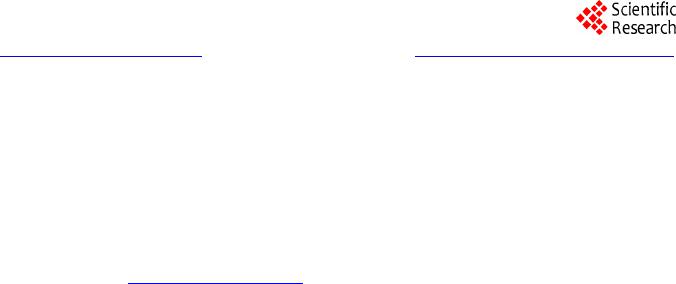
Advances in Anthropology
2014. Vol.4, No.1, 13-17
Published Online February 2014 in SciRes (http://www.scirp.org/journal/aa) http://dx.doi.org/10.4236/aa.2014.41003
Study on He Hong’s Dongba Manuscripts Collected by
American Harvard-Yenching Library
Xiaoliang Li
The Institute of Chinese Language and Documents, Southwest University, Chongqing, China
Email: longer_2411363@163.com
Received November 26th, 2013; revised December 24th, 2013; accepted January 19th, 2014
Copyright © 2014 Xiaoliang Li. This is an op en access article distributed under the Creative Co mmons Attribu-
tion License, which permits unrestricted use, distribution, and reproduction in any medium, provided the original
work is properly cited. In ac cordance of the Creative Commons Attribution License all Copyrights © 2014 are
reserved for SCIRP and th e owner of the intellectual property Xiaoliang Li. All Copyright © 2014 are guarded
by law and by SCIRP as a guardian.
American Harvard-Yenching Library has uploaded its Dongba manuscripts of Naxi on the official website.
Most of the Dongba manuscripts collection is featured with older version, good appearance, fluent and
elegant writing, and the portraits are true to life. Therefore, Harvard Dongba manuscripts collections are
definitely rare collections. Some of these manuscripts were written by He Hong, who was one of
well-known Dongba, native Naxi priests, in Baisha, Lijiang. This paper focuses on several aspects of the
title pages, writing style, postscript of He Hong’s manuscripts in order that we can understand the charac-
teristic of the Dongba manuscripts of Baisha.
Keywords: Harvard-Yenching Library; He Hong; Dongba Manuscripts
Introduction
The Naxi (also written Na-khi or Mo-so) is an ethnic minor-
ity in the northwestern part of Yunnan Province in China, near
the borders of Tibet and Burma. Their pictographic Dongba
(also written dto-mba or tomba) script is the only remaining
living pictographic language today. It is called the Dongba
script because it is primarily utilized by Dongba or priests when
they carry out their different ceremonies, rituals and exorcisms.
Dongba script was written on Dongba manuscripts. The actual
story of the Dongba manuscripts began way back in 1867 when
the French missionary, Pere Desgodins, sent an 11 pages copy
of Dongba manuscripts to Paris. Subsequently, more Dongba
manuscripts were brought back to Europe or America by trav-
elers in Yunnan and they were discussed in terms of the devel-
opment of writing (Jackson, 1989: p. 135). According to Britain
scholar Anthony Jackson’s survey, about ten thousand Dongba
manuscripts lost overseas.
There are 598 manuscripts in Harvard-Yenching Library, an d
the Harvard-Yenching Library’s holdings (510 from Joseph
Rock and 88 from Quentin Roosevelt) were acquired by Har-
vard-Yenching Institute in 1945. Joseph Rock, Zhu Baotian,
and Li Lincan edited these manuscripts respectively. Joseph
Rock catalogued the Dongba manuscripts collected by himself.
Li Lincan explained 21 pieces of these manuscripts and trans-
lated some manuscripts’ name into Chinese. Zhu Baotian cata-
logued all of those manuscripts and we can check the material
in his works An Annotated Catalog of Naxi Pictographic Ma-
nuscripts in the Harvard-Yenching Library. In addition, He
Jiquan, Deng Zhangying and Zhang Chunfeng have studied on
them respectively. He Jiquan translated the postscript of some
manuscripts and determined the identity of some classics writ-
ers. Deng Zhangying and Zhang Chunfeng studied the manu-
scripts stamped with two red circles. At present the Har-
vard-Yenching Institute, the Institute of Ethnology and Anth-
ropology, Chinese Academy of Social Science and the Institute
of Dongba Culture at the Yunnan Academy of Social Science
are translating the 598 manuscripts.
According to Li Guowen (1998: p. 227), He Hong was a
Dongba who lived in Baisha Town, Lijiang, during the late
Qing Dynasty. He was the nineteenth generation descendants of
a famous Dongba Jiuzhilao, and he is also the grandfather of He
Cheng who was a famous Dongba during the early Republic of
China. We have found that 50 manuscripts among the Harvard
Dongba manuscripts collections were written by He Hong.
These manuscripts are used in the ceremony for the prolonga-
tion of the life. The Naxi language pronunciation of the cere-
mony’ s title is zɿ33tʂu55, which means “long life connect”, and a
common theme is that things have been disconnected, for ex-
ample heaven and earth, mountain and valley, the cardinal
points, and of course longevity and the family. This ceremony
is to make good this interruption of continued long life (Jack-
son, 1979: p. 190).
This paper focuses on several aspects of the title page, writ-
ing style, postscript of He Hong’s manuscripts in order that we
can understand the characteristic of the Dongba manuscripts of
Baisha.
Postscript of He Hong’s Dongba Manuscripts
It is the direct evidence for us to determine the identity of the
writer if there is signature in the postscripts. Referring to the
following postscripts, we can determine that these manuscripts
are written by He Hong.
This page (Figure 1) is a postscript written in Dongba script
and the translation is, “it was written by He Hong who lived in
OPEN ACCESS 13